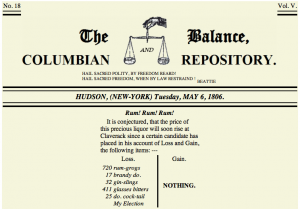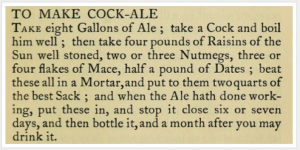 Last week, we considered the collegiate fashions of the 12th century. Now, as we encounter another Friday and approaching weekend, our attention is locked onto happy hour. Are we alone in thinking that this happiest of weekday hours also has the potential for deep conversations and random questions? As we pour ourselves one, we have to wonder:
Last week, we considered the collegiate fashions of the 12th century. Now, as we encounter another Friday and approaching weekend, our attention is locked onto happy hour. Are we alone in thinking that this happiest of weekday hours also has the potential for deep conversations and random questions? As we pour ourselves one, we have to wonder:
What is the origin of the happy hour cocktail?
“Cocktail” or Not?
To begin with, a good barfly should know what kind of drink she is ordering as she approaches the bar. What defines a “cocktail”?
The term first appeared in print in “The Balance and Columbian Repository” of New York on May 6, 1806 — and the article provided no definition. Rather, a political candidate who had lost the election provided a satirical itemized list of his campaign losses, including “411 glasses bitters, 25 do. cock-tail, My Election” (1). Approximately a week later, the paper’s editor responded to a confused reader who had asked “will you be so obliging as to inform me what it meant by this species of refreshment?”
The answer?
“As I make it a point, never to publish anything (under my editorial head) but which I can explain, I shall not hesitate to gratify the curiosity of my inquisitive correspondent: Cock tail, then, is a stimulating liquor, composed of spirits of any kind, sugar, water and bitters it is vulgarly called a bittered sling” (1).
The modern cocktail remains close to its 1806 roots. Different from a shot, martini, or blended drink, it is a short drink composed of a liquor combined with a juice or sugar based mixer.
While the exact etymology of the term remains unknown, our managing editor’s favorite possibility is that it derives from an early drink called “cock ale” that was popular in English huswifery manuals and receipt books of the 16th and 17th centuries (2).
But What About the Happy Hour?
Regardless of what you drink at happy hour — and the trends have changed across time — we also need to consider the origins of the gathering time itself.
As with the most interesting parts of our past, the exact beginnings of “happy hour” are difficult to pin down because they were sociable, communal, and oral. Many scholars believe that the actual term “happy hour” was appropriated from U.S. naval practice in 1920s. In order to assist seamen in releasing energy while on ship, the Navy sanctioned at this time a daily “happy hour” for wrestling, boxing, and other physical entertainment.
On land, Prohibition was shaping American drinking culture, and the expression became a euphemism for illegal drinking in the period between the end of the workday and the return to domestic life (3).
Hooked? Join in For More!
Tell us what you think or what other questions you might have in the Comments below or on Twitter. But first, subscribe to our features below so that you don’t miss a single quirky minute.
Resources:
(1) “The Origin of the Cocktail,” The Museum of the American Cocktail 2007.
(2) Kenelm Digby, “The Closet of the Eminently Learned Kenelme Digbie” (London, 1669).
Joel A. Klein, “Cock Ale: A Homely Aphrodisiac,” The Recipes Project 14 January 2014.
(3) Johnny Acton et. al. The Origin of Everyday Things (Sterling, 2006), 107.
